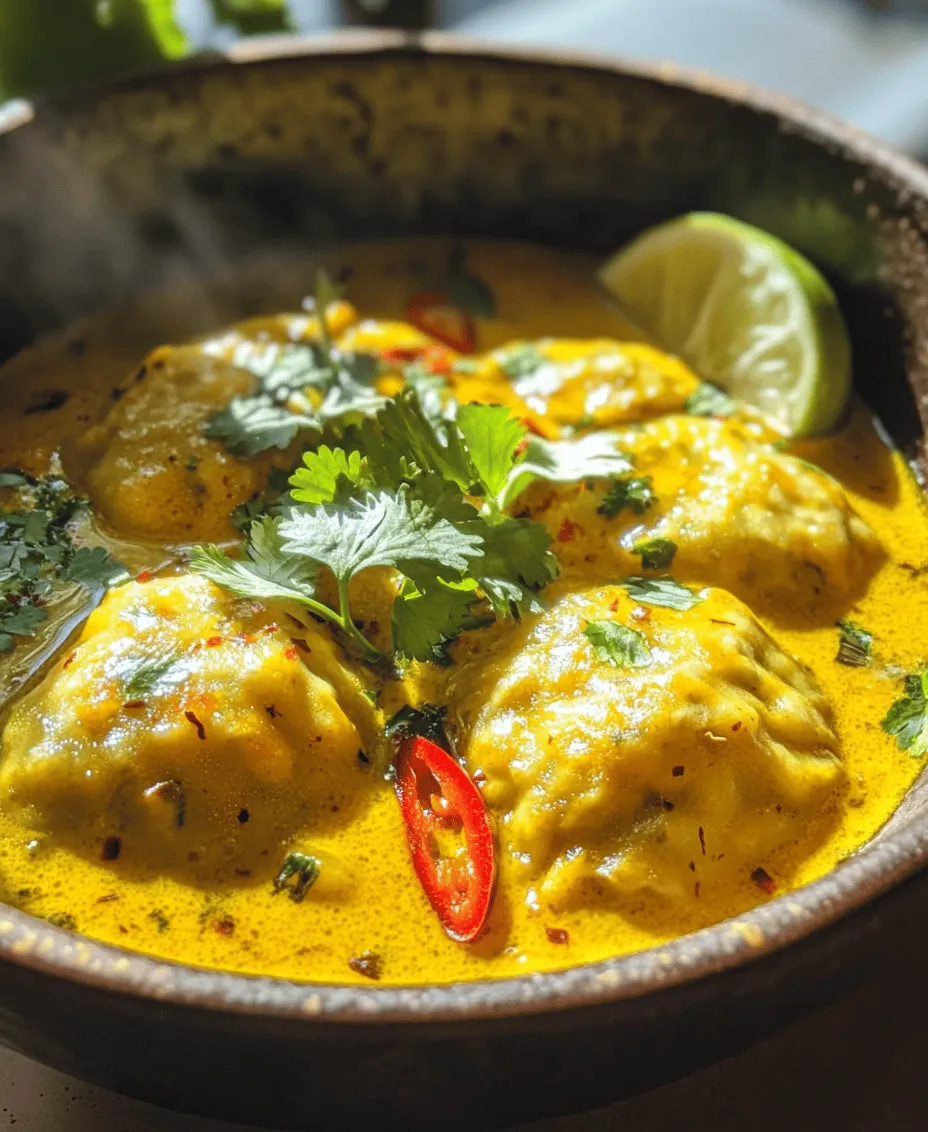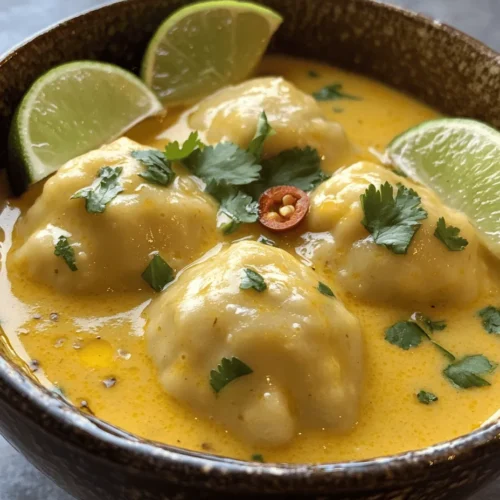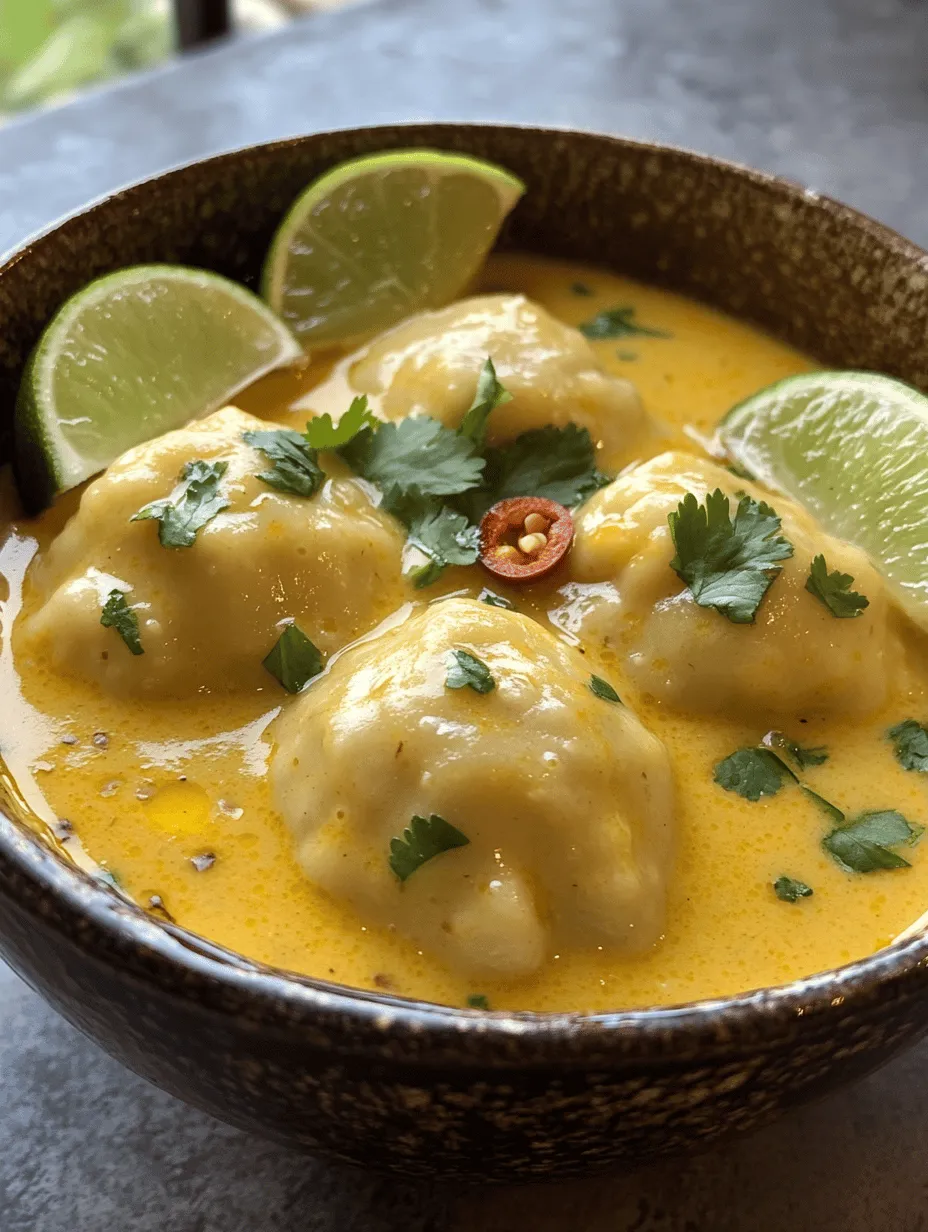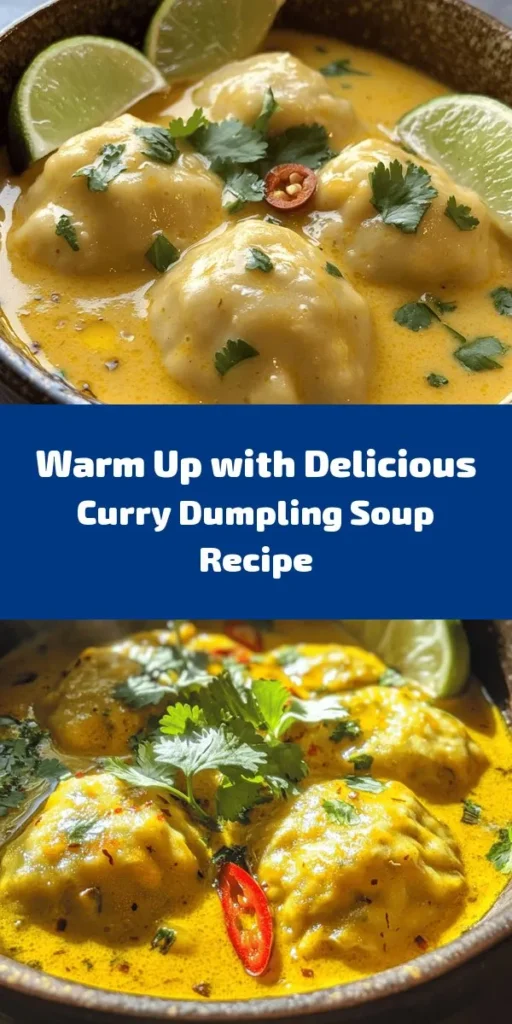Introduction
Curry Dumpling Soup is more than just a meal; it is a heartwarming dish that marries the delightful textures of dumplings with a rich, aromatic soup. This recipe not only warms your body but also fills your soul with its comforting flavors. Originating from various culinary traditions, dumpling soups are celebrated across many cultures – from Asian to Eastern European cuisines – each bringing its unique twist to this beloved dish. The versatility of Curry Dumpling Soup is one of its greatest assets; whether you prefer succulent meat or hearty vegetables, there is an option for everyone, making it a fantastic choice for family gatherings or quiet weeknight dinners.
The allure of dumpling soup lies in its ability to evoke feelings of comfort and nostalgia. It is a dish that often graces the tables of families during cold seasons or festive occasions. In many cultures, dumplings symbolize prosperity and togetherness, making this dish not only a culinary delight but also a vessel for cherished memories and traditions. Whether served as an appetizer or a main course, Curry Dumpling Soup offers a satisfying experience that transcends mere sustenance.
In this article, we will take you on a journey to master the art of creating the best Curry Dumpling Soup. We will explore the essential ingredients that contribute to its flavor and texture, provide a step-by-step guide to crafting the perfect dumplings, and share tips to elevate your soup game. Prepare to indulge in a recipe that promises to become a staple in your kitchen, bringing warmth and joy to your table.
Understanding the Ingredients
To create a memorable Curry Dumpling Soup, only the finest ingredients will do. Each component plays a vital role in achieving the perfect balance of flavors and textures. Let’s delve into the key ingredients that will elevate your dish and transform your cooking experience.
The Dumplings
Dumplings are the heart of this soup, providing both sustenance and a delightful chewiness that complements the broth. Here’s a closer look at the components that make up the dumpling dough:
– All-Purpose Flour: This is the foundation of your dumpling dough. All-purpose flour contains the right amount of gluten to create a structure that holds the dumplings together while still allowing for a tender bite. When mixed and kneaded properly, it forms a dough that is both resilient and pliable, making it easy to work with.
– Cornstarch: Incorporating cornstarch into your dumpling dough is a game-changer. It aids in achieving a tender texture, making the dumplings light and fluffy rather than dense. This ingredient helps to create a delicate balance, ensuring that the dumplings cook evenly and absorb the flavors of the soup beautifully.
– Seasonings: Salt is crucial for flavor enhancement, while baking powder serves to leaven the dough slightly, resulting in a more tender dumpling. These simple additions can significantly impact the final product, ensuring that your dumplings are not only delicious but also perfectly textured.
The Filling
The filling is where the magic happens, as it infuses the dumplings with flavor. Depending on your preference, you can opt for a protein-rich filling or a vegetarian alternative. Here’s a breakdown of the filling components:
– Proteins: For meat lovers, shredded chicken is a classic choice. It adds depth and richness to the dumplings. Alternatively, for a vegetarian version, tofu is an excellent substitute, providing a hearty texture while soaking up the flavors of the seasonings. Both options can be seasoned to perfection, ensuring that each bite bursts with flavor.
– Aromatics: Aromatics such as onions, garlic, and ginger are fundamental to flavor development. These ingredients release essential oils when sautéed, creating a fragrant base that enhances the filling. They provide a savory depth that complements the curry spices and rounds out the dish beautifully.
– Spices: The star of the show is the curry powder. This blend of spices varies in flavor profiles but often includes turmeric, cumin, coriander, and chili. The addition of soy sauce further boosts the umami flavor in the filling, creating a delicious contrast to the soup’s broth.
The Soup Base
The soup base is where all the flavors meld together, creating a harmonious and aromatic broth that envelops the dumplings. Here’s what to consider when crafting your soup:
– Broth Types: The choice of broth is crucial in determining the soup’s flavor. Chicken broth imparts a savory richness, while vegetable broth offers a lighter, plant-based alternative. Both options can be enhanced with additional spices and seasonings to create a robust foundation for your dumplings.
– Coconut Milk: This ingredient adds creaminess to the soup, balancing the spiciness of the curry. The natural sweetness of coconut milk rounds out the flavors, ensuring a delightful taste experience. This is especially important in a curry dish, as it creates a comforting mouthfeel that complements the dumplings.
– Curry Paste: The choice between yellow or red curry paste can dramatically alter the soup’s flavor profile. Yellow curry paste is typically milder and sweeter, while red curry paste tends to be spicier and more complex. Selecting the right paste for your palate is essential; consider the overall flavor balance you wish to achieve in your dish.
Step-by-Step Guide to Making Curry Dumpling Soup
Now that we have a comprehensive understanding of the ingredients, it’s time to roll up our sleeves and get cooking! We will break down the process into distinct sections for clarity, focusing on creating the dumpling dough and preparing the filling.
Creating the Dumpling Dough
1. Mixing the Ingredients: In a large mixing bowl, combine your all-purpose flour and cornstarch. Add a pinch of salt and baking powder, ensuring that the dry ingredients are evenly distributed. Gradually add water, mixing until a shaggy dough begins to form.
2. Kneading: Transfer the dough onto a lightly floured surface. Knead the dough for about 5-7 minutes until it becomes smooth and elastic. The kneading process is crucial as it develops the gluten, giving the dough its structure.
3. Resting the Dough: Once kneaded, cover the dough with a damp cloth or plastic wrap and let it rest for at least 30 minutes. This resting period is essential, as it allows the gluten to relax, making the dough easier to roll out and shape.
Preparing the Filling
1. Sautéing Aromatics: In a skillet, heat a tablespoon of oil over medium heat. Add diced onions and sauté until they become translucent. Follow with minced garlic and grated ginger, cooking for an additional minute until fragrant.
2. Adding Proteins and Spices: If you are using shredded chicken, add it to the skillet and cook until it’s fully heated through. For the tofu option, add cubed tofu and let it absorb the flavors. Sprinkle in your chosen curry powder and a splash of soy sauce, stirring everything together until well combined. Remove from heat and allow the filling to cool slightly before using it in the dumplings.
As you prepare the dumpling dough and filling, the aroma of spices and sautéed ingredients will fill your kitchen, setting the stage for a delicious meal. In the next section, we will continue with the process of assembling the dumplings and crafting the flavorful soup that will envelop them. Stay tuned for the continuation of this culinary adventure!

The Best Curry Dumpling Soup Recipe: A Culinary Adventure
Cooking is a journey, and the path to creating the Best Curry Dumpling Soup is no exception. This dish not only tantalizes the taste buds but also provides a comforting embrace on chilly days. As we delve into the intricacies of this recipe, we will explore the vital steps in crafting the dumplings, preparing the soup, and serving it beautifully.
Importance of Cooking the Filling Thoroughly
Before embarking on the assembly of your dumplings, it’s crucial to ensure that your filling is fully cooked. Thoroughly cooking the filling serves multiple purposes:
1. Safety: It eliminates any potential foodborne illnesses that could arise from using raw proteins.
2. Flavor Development: Cooking the filling allows the flavors to meld together, creating a more cohesive taste profile.
3. Texture: A cooked filling prevents excess moisture from being trapped inside the dumplings, which could lead to sogginess during cooking.
Forming the Dumplings
Now that you have a flavorful filling ready, it’s time to assemble your dumplings. Here are some effective techniques to ensure they hold their shape during cooking:
1. Rolling the Dough: When rolling out the dumpling wrappers, make sure they are evenly thin but not so thin that they tear easily. Aim for about 1/8 inch thickness. Use a round cutter or a glass to cut out circles that are approximately 3 inches in diameter.
2. Filling and Sealing: Place about a tablespoon of filling in the center of each wrapper. To seal, moisten the edges of the wrapper with a bit of water. Fold the dough in half over the filling to create a half-moon shape. Press the edges firmly together to ensure a tight seal. For an added touch, you can crimp the edges using your fingers to create a decorative pattern.
3. Common Mistakes to Avoid:
– Overfilling: This can cause the dumplings to burst during cooking. Stick to the recommended filling amount.
– Not Sealing Properly: Make sure there are no air pockets trapped inside the dumpling, as this can lead to leaks.
Preparing the Soup
With the dumplings assembled, the next step is to prepare the curry soup. The process begins with sautéing the curry paste:
1. Sautéing the Curry Paste: Heat a tablespoon of oil in a large pot over medium heat. Add the curry paste and sauté it for about 2-3 minutes. This step is essential as it releases the aromatic oils and enhances the flavors.
2. Incorporating Broth and Coconut Milk: Gradually pour in your vegetable or chicken broth, stirring continuously to combine it with the sautéed curry. Follow this with the addition of coconut milk, which not only adds creaminess but also balances the spice of the curry. Allow the mixture to simmer gently for about 10 minutes, letting the flavors meld.
Cooking the Dumplings
Once your soup is ready, it’s time to cook your dumplings:
1. Cooking Process: Gently drop the assembled dumplings into the simmering soup. Be careful not to overcrowd the pot, as this can lower the temperature of the soup and lead to uneven cooking.
2. Signs of Doneness: Dumplings typically take about 5-7 minutes to cook, depending on their size. They are done when they float to the surface and have a slightly translucent appearance.
3. Variations in Cooking Times: If you have larger dumplings, they may require a few extra minutes. Always cut one open to check that the filling is piping hot before serving.
Finishing the Soup
Adjusting the soup’s seasonings is an essential step to cater to your taste preferences:
1. Seasoning Adjustments: Taste the broth and add salt, pepper, or extra curry paste as needed. If the soup feels too rich, a splash of soy sauce can help balance the flavors.
2. Brightening with Lime Juice: Just before serving, squeeze in some fresh lime juice. The acidity not only brightens the dish but also complements the richness of the coconut milk and curry.
Serving Suggestions
To present your Curry Dumpling Soup beautifully, consider the following garnishing ideas:
– Fresh Cilantro and Lime Wedges: Sprinkle chopped cilantro on top for a burst of freshness and serve lime wedges on the side for an extra zesty kick.
– Optional Garnishes: Sliced chili peppers can bring heat to the dish, allowing for personalization based on individual spice tolerance.
Nutritional Insight
This delicious soup is not only satisfying but also packed with nutritional benefits:
– Protein: Depending on your filling choice (chicken, shrimp, or tofu), this soup can provide a substantial amount of protein.
– Vitamins: Ingredients like cilantro and lime juice add vital vitamins, particularly vitamin C, which is important for immune function.
– Healthy Fats: The coconut milk used in this recipe provides healthy fats that are beneficial for heart health.
Culinary Variations and Adaptations
The beauty of Curry Dumpling Soup lies in its versatility. Here are some variations to consider:
– Different Protein Sources: You can easily swap the filling for shrimp, pork, or even plant-based options like lentils or mushrooms for a vegetarian version.
– Gluten-Free or Low-Carb Options: For gluten-free dumplings, try using rice flour or gluten-free wrappers. If you’re looking to reduce carbs, consider wrapping vegetables or using zucchini noodles instead of traditional dumpling wrappers.
– Adding Vegetables: Enhance the nutritional value of your soup by adding vegetables, such as spinach, bok choy, or carrots, during the final stages of cooking.
Cultural Context and History
Dumpling soup has a rich history across various cultures, from Chinese wonton soup to Eastern European pierogies in broth. Each culture has its own unique variations and fillings, showcasing the universal appeal of dumplings as a comforting food. The art of making dumplings has been passed down through generations, evolving with regional ingredients and preferences.
Conclusion
The Best Curry Dumpling Soup is a delightful fusion of flavors, textures, and aromas that invites creativity in the kitchen. Whether you follow the traditional recipe or experiment with your own twists, this soup provides a wholesome meal that can adapt to suit any taste or dietary preference. Embrace the process of making this dish; it’s not just about the end result but also about connecting with culinary traditions and enjoying the nourishing warmth that this soup brings to the table. So gather your ingredients, roll up your sleeves, and embark on a culinary adventure that promises to delight both you and your loved ones.



